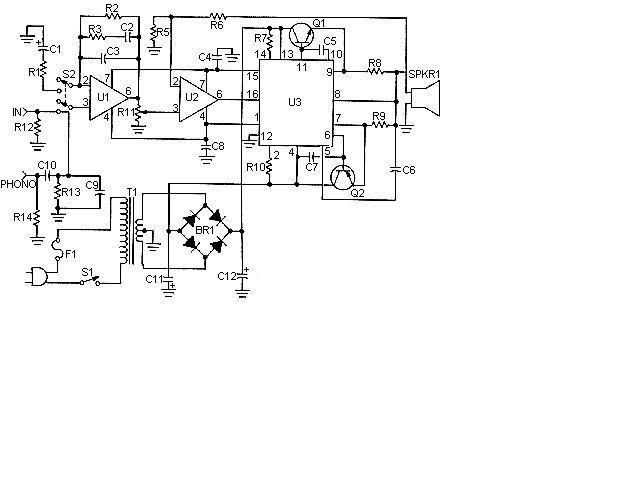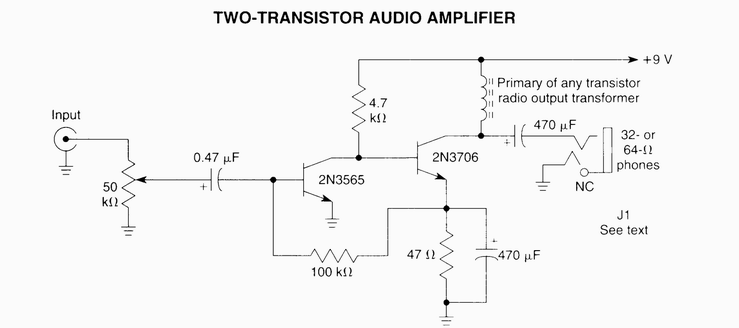This is a handy, easy to build general purpose 50 watt amp. The amp has an input for a radio, TV, stereo or other line level device. It also has a phono input for a record player, guitar, microphone or other un-amplified source. With the addition of a low pass filter at the input, it makes a great amp for a small subwoofer.


Parts
R1(1)200 Ohm 1/4 W Resistor
R2(1)200K 1/4 W Resistor
R3(1)30K 1/4 W Resistor
R5(1)1K 1/4 W Resistor
R6(1)5K 1/4 W Resistor
R7,R10(2)1 Meg (5%) 1/2 W Resistor
R8,R9(2)0.4 Ohm 5 W Resistor
R11(1)10K Pot
R12,R13(2)51K 1/4 W Resistor
R14(1)47K 1/4 W Resistor
C1(1)100uF 35V Electrolytic Capacitor
C2(1)0.011uF Capacitor
C3(1)3750pF Capacitor
C4,C6(2)1000pF Capacitor
C5,C7,C8(3)0.001uF Capacitor
C9(1)50pF Capacitor
C10(1)0.3uF Capacitor
C11,C12(2)10,000uF 50V Electrolytic Capacitor
U1,U2(2)741 Op Amp
U3(1)ICL8063 Audio Amp Transister Driver thingy
Q1(1)2N3055 NPN Power Transistor
Q2(1)2N3791 PNP Power Transistor
BR1(1)250 V 6 Amp Bridge Rectifier
T1(1)50V Center Tapped 5 Amp Transformer
S1(1)SPST 3 Amp Switch
S2(1)DPDT Switch
F1(1)2 Amp Fuse
SPKR1(1)8 Ohm 50W Speaker
MISC(1)Case, Knobs, Line Cord, Binding Posts Or Phono Plugs (For Input And Output), Heatsinks For Q1 And Q2
- I know I skipped R4. That is not a problem :-)
- Distortion is less than 0.1% up to 100HZ and increases to about 1% at 20kHz.
- I haven't been able to find anyone who sells a suitable T1. You can always use two 24V 5A units in series. If you are building two amps (for stereo), then I would suggest using an old microwave transformer and rewinding it. Follow the instructions in the 12V To 120V Inverter, execpt wind 26 turns, twist a loop (center tap) and wind 26 more turns. That should work out to around 50 volts. You may need to add or remove turns depending on your transformer.
- Q1 and Q2 will require heatsinks.
- You may have trouble finding U3 because it is discontinued. Please don't email me about sources...I can't find it either. See if any of the sources in Where To Get Parts has it. A possible source was sent in by JBWilliams

















